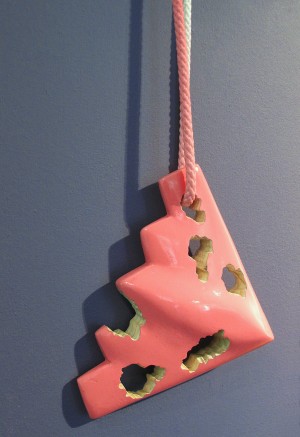

De Beijer’s work is not intrinsically inspired by anything specific, but driven by mystical and romantic urges. “I find myself wanting to create stories and seeing symbolism in a wide range of (contemporary) events and objects. I build a sort of conspiracy theory around things that I feel have a tendency for this. It is maybe a bit like writing a visual sci-fi movie script, using my strictly personal view.”

Boris’s romantic vision is not one of baroque finery or Victorian lace, but the new romance of the post industrial age – one that looks back with nostalgia at our own histories, our own childhoods and the cultural products of modernity.
The classical understanding of jewelry, especially that which has historical significance as ritual object, is of the utmost importance to Boris’s approach. However to challenge its historical counterpart, wearability is secondary to his projected concept and its perceived outcome.

“I try to give my works the same kind of feeling, as if they are really meant for ritual use, or designed to be worn by a priest from a another galaxy in the far future… I find it hard to imagine that someone would wear my jewelry on a daily basis. I think I am sometimes trying more to imitate and depict jewelry than to really make it functional and wearable.”
And to some extent the work does read as a caricature of itself. Although the work is crafted to a very high standard and not impossible to wear, there is a clumsy ingenuousness about it. In the same way Atari video game graphics circa 1982 are clumsy relative to the cinematic quality of Gears of War,a hot new game all the kids ( and some adults) are playing. The works are pixilated reproductions of “real” ritual objects. Softened by the low resolution, they are intentionally vague, giving off an air of sinister humor or ridiculousness. This may sound disparaging but by the titles given to the works we know that this is Boris’s intent.
“I wanted to give the works light names which would leave space open for a personal interpretation, yet direct a little to what the piece could have been meant for. And with light names I mean a bit humorous, although I imagine the pieces to be mostly of quite an evil origin.”
And if your desk in seventh grade math class was anything like mine – it was unquestionably from evil.
Boris de Beijer has recently graduated from the Gerrit Rietveld Academie, Amsterdam.
His work may be seen at Gallery RA.
For more information visit:
For more images of de Beijer’s work visit:
http://www.ninette.nl/work/applied/collection-boris-de-beijer/
Kerianne Quick is an American materialsmith and craft writer currently living in Amsterdam, The Netherlands





